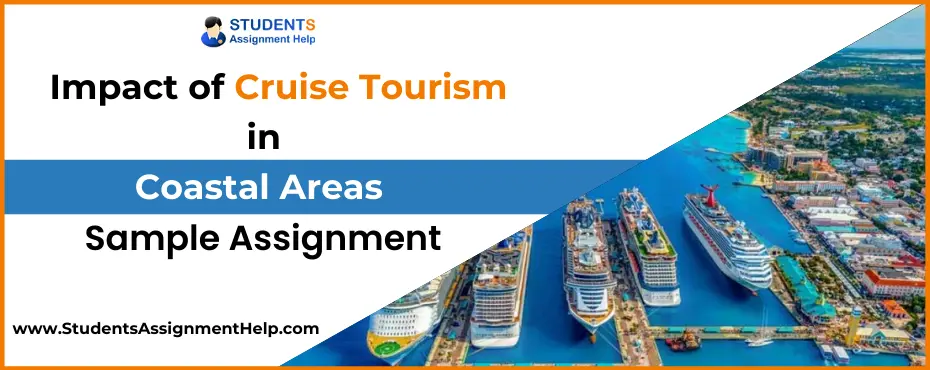Impact of Cruise Tourism in Coastal Areas – Sample Assignment

Executive Summary
In recent years, the new form of coastal tourism has earned a well-deserved reputation. The purpose of the report is to find the economic, social, and environmental impact of cruise tourism in coastal areas. The study assesses the industry growth, trends, impact of cruise tourism, and tourism-related developments along with coastal areas. The study traces the origin of coastal transformation with a particular focus on the real estate and construction boom in coastal areas. Despite a large number of economic benefits received by the coast the areas also suffer from many problem such as loss of marine resources, pollution of marine water resources, air pollution, climate change assignment help, loss of cultural resource and public access etc. The given report also focuses on challenges and opportunities for maritime and coastal tourism. The reports builds on information collected from various sources such as journal, books and online articles. The report recommends need of a sustainable tourism strategy in collaboration with government, industry and community.
Introduction
Cruise industry is one of the sectors that have grown by 2,100 percent since their start. Since the beginning of 1960, there has been rising trend in the cruise ship tourism. For the period 1990-2007, the cruise passenger annual growth rate has increased to 70 percent. The average annual growth rate of cruise tourism is almost twice the rate of growth of the tourism industry. The growth rate of cruise tourism is expected to continue in future (FCCA, 2008). Cruise tourism is new phenomena with serious impacts on three pillars of sustainability, i.e., economic, social and environmental. The increase in cruise ship traffic and infrastructure has identified negative impacts such as incompatible development, loss of culture, pollution, and wear and tear.
The cruise market is continued to grow irrespective of its negative impact because regulation in response to these issues is still under development. The revenue of the cruise industry is 3 percent of the total international tourists receipts (Kester, 2002). Four cruise lines, i.e., Carnival, Royal, Caribbean, and P&O., dominate the cruise industry. The most famous cruise destination of the world is Caribbean, Bahamas because of its proximity with the world’s largest cruise market (Orams, 2002). The report will study the recent trends and development in the cruise industry. In relation to this, the given research will analyze the various impacts of cruising on coastal areas and challenges faced by them. As the ship order and number of passenger grows, the significant impact is seen on socio-cultural, economic, political and environmental factors. The report also proposes recommendation for building a sustainable future for cruise destination.
Flexible Rates Compatible With Everyone’s Budget
Hire a Professional Essay & Assignment Writer for completing your Academic Assessments
Recent trends in Coastal Cruise industry
The cruise ship industry is one of the fastest growing segments in the tourism and travel industry. The growth of the cruise industry can be measured from different aspects such as demand, supply and output of the sector.
The Table 1 and Figure 1 describe the continuous increase in cruise passenger arrivals and growth in the number of passengers for the period 1997-2007.
(Source: CLIA 2008)
The average annual growth rate of the number of an international cruise passenger is 7.4 percent for the period 1990-2007. It can be derived from the Table 1 the participation of North American passenger is more than 80 percent but is in declining trend. The cruise industry shows high demand from new sources such as Europe and Asia (Brida and Zapata, 2010)
Presently, the tourism development trend emphasizes on increasing passenger capacity or building larger vessels of cca 3.000 (Passenger shipping association, 2006). Hence, the trend to increase the guest capacity will mark the future of cruise tourism industry. It will also have many different impacts on the respective ports and coastal areas. The most intensive tourism region worldwide is Mediterranean. It is the most growing region with increasing cruise activity; accounting for 18 percent of the world cruise market in 2006.The rapid growth of cruising tourism has increased competition and put high pressure on coastal resources and infrastructure. An increasing number of new generation cruise ships have created large environmental burden on local communities. The increasing cruise ship resorts have limited the economic benefits to local people residing in coastal areas (Caric, 2011).
Cruise ship vacation is the rapid growing segment in the leisure travel industry. The ship size, number of cruise, passenger, ports and revenues all are on rising trend. Since 2006, the number of people took cruise vacation rose half million crores. The industry has witnessed dramatic increase in number and size of cruise ships. Nearly 88 ships have been introduced, and 200 large cruise ships are in service pipeline. The ship size has also increased from 500-800 to accommodate passenger. The Royal Caribbean is the biggest cruise ship with the capacity to accommodate 3,634 passengers plus with an additional crew of 1500 members.
The top ten cruise destination hold the 90 percent of cruise ships. The Caribbean is a favorite tourism destination among tourist. After the 9/11 attack, the cruise tourism attraction has shifted from Mediterranean to Caribbean region. The Caribbean region is capitalized to be a safe and terror-free travel destination. It is worth noting that despite 9/11 attacks, the SARS virus and economic recession there have been raising trend in cruise tourism. The consumer interest is continued to be strong despite high pressure on travel cost. The travel cost has increased due to the economy and fuel costs
Figure 2: The top ten cruise geographical destination
1. Caribbean (41), 2. Mediterranean (19), 3. Europe (9), 4. Alaska (9), 5. Mexico-West (8), 6. South America (6), 7. South Pacific (3), 8. Canada-New England (1) and 10. Bermuda (2).
Source: (CLIA 2007)
The recent trend shows that 77 percent of past cruise vacationer and 50 percent of vacationer who is yet to express cruise experience, express interest to do so in next three years. As described in figure 2, Caribbean region, has high potential growth as the local governments are developing and investing the large amount of money in building quality infrastructures to attract the cruise ships and passenger arrivals. Few governments have developed marketing strategy to encourage cruise line by paying them the monetary incentive on arrival of each passenger.
Moreover, marine and coastal tourism is the largest segment in the tourism industry. The visitors after 9/11 attacks for economic convenience and security opt for prepaid packages on cruise ships and resorts. The trend is expected to increase as there is an increase in urbanized population particularly in US, Europe and Asia. The rise in income of the middle class would like to seek nature and hence choose coastal cruise tourism.
The coastal region of Panama, Costa Rica is experiencing rapid development in marine and coastal tourism because of the proximity with North America. The regions are also known as vacation homes and are experiencing the boom of the coastal tourism and resort developments. However, it has caused many environmental, social and cultural impacts on coastal regions. In 2007, Costa Rica government took the initiative for sustainable tourism development and for making the country carbon neutral by the end of 2023. The region has high resort development in the Pacific Coast.
The new variant to the latest trend in coastal development is residential tourism. Currently, the development of resort complexes is the hottest trend. However, the new model of combining resort with vacations homes has the serious impact on environment and local community. The biggest challenges face by coastal resort developer is on land ownership, displacement of locals, water, environmental destruction and global warming (Global trends in coastal tourism, 2007).
The impressive growth rate in cruise tourism is expected to record 25 million cruise passenger by 2015. However, the Asia Pacific market share is less but the trend is likely to change as soon the barriers to entering the market will be removed by regulators. The climate and time of year are important factors in choosing a cruise destination. The Asia Pacific region is a rare tourism destination but the volume of cruise tourists is constantly increasing from last few years. The cruise tourism is segmented into four: luxury, premium, contemporary and budget. The period 2006-2010 has seen the fast growth in contemporary followed by luxury segment. The two segments hold the specialization in items of itineraries and ships. Hence, this trend makes the cruise segment move up for the resort development (Kim, 2012).
Impacts of cruising in coastal areas
Coastal areas are highly biodiversities transnational areas between land and seas. The coastal area is surrounded by the richest ecosystems of the earth such as mangroves and coral. Also, they are densely populated due to rapid urbanization process. The half of the world population lives near coastal area. At the same time, coastal areas are a favorite destination place. Moreover in much coastal area tourism is the most vital economic activity. For example in Mediterranean region tourism is the only activity for its island like Malta, Cyprus, etc. However, Cruise tourism has both positive and negative aspects on the environment, economic and on society.
Economic analysis-
Cruise tourism seems to have direct and indirect effect on the economy of the region. The arrival of any cruise ship and passenger has the considerable change in the destination and local communities. Cruise tourism is most likely to benefits industries like transportation, tour operators, and specialist shops. The other business like hotel, liquor stores and casino may not see significant gains from cruise tourism. Cruise lines create direct economic impact, who sells goods and services to cruise vessel, passengers and crew members. The expenditure of cruise is related to vessel, crew expenditure and support services expenditure. The indirect contribution to government revenues are taxes, duties on goods and services, taxes on tickets, souvenirs, alcohol, restaurant, etc. In 2000, the total revenue generated worldwide by cruise industry was US$16.4 million.
The revenue from the industry benefits the government and citizens of the country. The cruise tourism also creates employment opportunities for the local people. The positive impact of sustainable tourism is contribution to government revenues, increase in foreign earnings, employment generation and business opportunities. However, in recent time cruise industry has become a lobbying group in port destination by creating their private island property for each cruise line. The community people are restricted to enter in these private islands and hence it reduces the economic benefit for local tourism (Brida and Zapata, 2010).
Environmental Impact-
Cruise tourism creates pressure on resources that are in short supply such as energy, food, water and soil. A study conducted by British Airway has exposed the environment impacts done by cruise tourism. To serve cruise line destination, modification are done to the natural environment that result in loss of habitat and explosion of local construction. The operational impact on the environment is accidental or deliberate physical damage of marine ecosystems. The cruise tourism can lead to loss of biodiversity, for example, competing with wildlife for habitat and natural resources. The various types of waste and damage produced by 3,000-passenger cruise ship are:
The other types of environment impact are degradation of irrigation land, erosion of soil and destruction of plants and degradation of geological, historical sites. As per the report from Oceana the fuel consumption of cruise ship is equivalent to 12000 vehicles. The spillage and illegal dumping of waste by cruise ship contain toxic substances, organic residues that adversely affect the sensitive areas considerably. However, the large proportion of legislation on waste generated by cruise ships has been made a decade back. It is difficult to apply legislation because many ship sale under flag of convenience. Recent, MARPOL convention is introduced as a framework to prevent the marine pollution from ships. The MARPOL has six annexes to regulate the dumping from ships. MARPOL for special ecological areas has set strict criteria on waste dumping (Protecting the world’s oceans, 2013).
Social and Cultural effects- Cruise tourism has rapidly grown as the favorite type of vacation space. In addition to economic displacement and health and ecological impact, the development of cruise tourism result in behavioral transformation. The largest social issue faced by local community is change of local identity and values. Tourism has commercialized the local culture, tradition, festivals to conform to cruise tourist expectation. To meet the tourist expectation, the destinations are modified. The standardization factor damages the beauty of diverse cultures.
To adapt to tourist demands, craftsman make changes in design of their product. It results in cultural erosion. The cultural clashes also arise because of economic inequality. The destinations are at the risk of losing cultural authenticity in the process of commercializing culture traditions. The local residents of destination Caribbean have adopted the habits and patterns of the tourist. A common problem faced by many destinations is people pollution. Nova Scotia, a small island destination experiences shortage of public transport during peak season of visitors (Brida and Zapata, 2010).
Buy high-quality essays & assignment writing as per particular university, high school or college by UK, USA & Australian Writers
Issues and challenges facing the cruise industry
Demand for innovation in shore excursions-
The innovative shore excursion is in great demand among tourist. The success of continuous growth in the cruise industry goes to innovative shore excursions to attract cruise line and cruise passengers. Shore excursion is an integral part of cruise experience; it helps the passengers to understand the destination visited. Cruise lines often try to differentiate on providing distinctive itineraries according to passenger preferences. Cruise line select port of call to meet the passenger expectation. In recent years, the cruise lines are expanding shore excursions to match with the active lifestyle of tourists. The tour operators are adding traditional activities such as nature walks and city tours. The cruise industry has seen a dramatic increase in family cruising. Therefore, cruise lines are continuously expanding the myriads activities and facilities. It is a challenge for the cruise line to continue provides the new experience by creating innovative shore programs, designs especially for cruise passenger and experienced travelers.
Service standards-
The future challenges for the cruise line industry is to continue provide service that differentiate their brand from other cruise lines. The cruise line success and reputation are highly dependent on the standards and the variety of on-board service provide by a cruise vessel. The most common service is fine dining, spa facility, shore excursions, entertainment offers and extraordinary services. As the cruise industry expands, 30-40 percent of experienced tourist expects the development and increase in the level of service standards.
On-board revenues-
The decline in cruise ticket prices is posing a challenge for the cruise line to discover the new source of revenue. The cruise lines makeup revenue out of impulse purchases by travelers at on-boards bars, the art functions or the stores. Providing high variety of on-board service is crucial to the success of the cruise line. In recent years, cruise line such as Sea Dream, River Sea is offering distinctive amenities in voyages. The future challenge for the cruise line is to offer services that are compelling and different from other brands.
Fuel-saving and environment issues-
The biggest challenge for the cruise industry is to maintain a balance of cost, customer preferences, regulation and innovation in technology. The great challenge and problem for the cruise line is raising fuel cost. The large cruise line is very sensitive to the problem of fuel cost. The small ships are not much affected by rising fuel prices as they spend less time cruising and burning fuel. However, many cruise lines are looking at new fuel conservation measures. The cruise lines are now using software plans to plan voyages and maximize fuel efficiency. The newly built cruise vessels save lot of energy by equipping with flat-screen televisions and using LED lights in place of standard lights. The environment challenges in the cruise industry are related to air pollution, black water, wastewater, solid waste, hazardous disposal of chemicals and coral reefs.
Creating demand ahead of supply-
The increasing popularity of cruising vacation is posing a challenge for land based tours. The cruise lines are facing scarcity of highly skilled and experienced sales force to create demand for cruising. Hence, the healthy growth of the cruise industry is dependent on the creation of continuous demand, high consumer satisfaction rate and improvement in the economy (Challenges and Future Trends: Ports and Passengers in Europe, 2007).
The European Union has identified some of the key challenges and problems faced by coastal tourism: the private and public entities involved in coastal tourism lacks effective and coordinated governance. Carbon Dioxide emissions issues drastically affect the coastal regions and island destinations. The change in climate leads to increase in coastal erosion. Hence, it requires high cost for coastal protection. The tourism infrastructure is at risk and needs to be protected. The coastal tourism has limited availability of a specific sector related information; also it restricts networking opportunities for SME in cruise tourism. The challenge for the industry is a requirement of high skill people to meet the demand of visitors. The coastal cruise tourism has harmful effects on marine tourism includes threatening of habitat, exploitation of endangers species, marine littering and creating the problem of fresh water scarcity.
The increase in economic use of coastal and seas for aquaculture, energy production and marine transport intensifies the competition for space.
The rising growth of cruise shipping sector is a challenge in terms of safety, security, air emission, energy efficiency, and on-board waste and increasing port congestion. The Europe is the most attractive cruise destination of the world, but the coastal infrastructures are not adequate to meet the need of the cruise industry (European commission, 2013).
The continued growth in the cruise market requires cohesive approach from the tourism industry. The challenges faced by sector are ensuring adequate infrastructure and transport facility for visitors, and regulating entry customs procedures at ports. Maintaining the quality of onshore excursions and providing comfortable passenger transport into city centers are the few challenges of coastal cruise industry (sector Marketing, 2014).
Currently, the cruise industry lacks a proper regulatory framework. The key problem is that the system is insufficient to address above concerns. Presently, MARPOL 73/78, the International Convention for the Prevention of Marine Pollution, establishes standards and guidelines for cruise ships. The guidelines of MARPOL are insufficient for dealing with waste generated by ships. Hence, it can be concluded that regulatory control instruments are not sufficient to address environmental problems.
A major problem in the cruise industry is highly geographically and economically concentrated representing few major corporation such as Carnival, Royal Caribbean and Star Cruises. The lobbying power of corporate cruise giant has granted them tax incentives and other savings that result in competitiveness of cruise prices (Caribbean Cruise Ship Tourism and the Environment: a Policy Proposal, 2010)
Recommendation
It is recommended to adopt a new model or approach to sustainable coastal tourism development. Tourism is the fastest growing industry in the world. It is an important source of revenue, employment generation and wealth in many of the countries. However, the rapid expansion of industry has detrimental impacts on environment and social-cultural in many regions. Coastal tourism is the important segment of the tourism industry. The key product of coastal cruise industry is natural resources. The primary aim of sustainable tourism is to promote triple bottom-line focused business. The purpose of sustainable practice is to prove all sectors of industry with establish guidelines that seek to reduce the negative impact of the industry. Through generating sustainable coastal tourism practice the impact on the environment, socio-cultural and economic can be minimized.
The environment impact can be minimized by generating sustainability as follows:-
Investment in Waste Management Technology- The cruise produce the massive amount of waste in the seas, it is important that they soon implement the effective waste management systems to minimize the negative impact on the environment. The investment in waste water treatment such as ULTRA-SEP 10000 is one of the solutions to eliminate the problem of the large amount of waste water released in the ocean. The system processes ten cubic meters of bilge water per hour. The system is now carrying certification from the United States Coast Guard. Companies such as PyroGenesis Inc. have developed a plasma energy technique that converts wastewater into gas and is then fully treated in a separate chamber before releasing it. The impact on the environment will greatly be minimized if all cruise line invests in such technologies.
Developing Environmental programs-
The cruise line should adopt aggressive environment programs of waste reuse and recycling, waste stream management and programs on shore side disposal. However, many cruise lines have introduced environment programs on board that are in compliance with environment standards set by International Maritime Organization (IMO), MARPOL and International Council of Cruise lines (ICCL). The cruise line should build programs and implement the best practice to eliminate the waste from the ocean.
Urgent requirement of Certification-
An immediate need for governments, NGO, and business and communities is present to adopt sustainable tours practices. Therefore, it is necessary to develop certified programs that can apply to all coastal regions. The certified programs will ensure the public that the cruise line are meeting the stringent environment standards. It will create a competitive advantage for the cruise line in the form of improved community relations and increase in goodwill of corporate. The certification program will decrease the chance of lawsuits on cruise corporations. Certification programs are essential to encourage consumers for sustainable production and consumption practices. Till now, there are 60 environmental certification programs providing sustainable practices.
Community Involvement and development-
Coastal tourism is a positive phenomenon that binds people and community in the islands. It is essential to involve local communities for the success of sustainable tourism. The development of community is the cornerstone of any sustainable cruise tourism endeavor. The key component of community development is to provide sufficient physical infrastructure to attract tourist and simultaneously benefitting the local community. The local community and civic should fight for the preservation of the environment. Cruise line should redistribute the benefits generated by business with local community.
Education and training to visitors and local-
It is important to educate visitors and local to respect the local heritage, values, tradition, crafts and arts. The culture and tradition of the coastal region can be preserved only through sustainable management of natural resources.
Developing long term goals-
The government of coastal regions should develop a long-term vision of tourism in their respective islands. The government should work on the new source of revenue for the country and should not rely only on tourism for economic development.
Conservation of resources-
The aim of sustainable tourism is to maximize benefits for all stakeholders. The number of traveler support environment programs that minimize pollution, waste and energy consumption. The travelers by helping cruise industry can preserve natural resources and continue enjoy the exponential growth of the industry.
Expansion of local business opportunities-
The collaboration of the cruise line with local business provides an opportunity to the indigenous community to participate in the tourism industry (Sustainable tourism and the Cruise line industry 2005).
Benefits of sustainable coastal tourism
There are numerous benefits of sustainable coastal tourists. The sustainable coastal tourism contributes to government revenues, generates foreign exchange earnings, employment generation and contributes to local economies. The social-culture benefits of sustainable practice are an initiative to strengthen communities, improves the preservation of culture and traditions. The sustainable tourism encourages social involvement and stimulates feeling of pride in local residents for national heritage. The sustainable practices benefits visitors in the form of unspoiled nature, clean environment, and safety and ensure authentic local culture and traditions. The sustainable tourism contributes directly to conservation of natural resources and habitat (Sustainable Development of tourism 2012).
Conclusion
Hence, it can be concluded that cruise tourism is the largest generator of revenue and jobs in the world. However, the cruise industry puts strain on the natural resources of coastal regions. The pressure is evident in all areas such as environment, social and the economy. The negative impact across all areas becomes essential for the cruise industry to adopt sustainable practice for long-term success. The significant growth in the industry and number of visitors makes it necessary for all stakeholders to adopt sustainable practices. In the future, it is expected that more than 10 million people will travel by cruise. The cruise industry is growing by 6.6 percent. It is one of the favorite segments of tourism.
The cruise industry has made a significant impact on natural and cultural systems. Hence, it is essential for the industry to develop practice that minimizes the harmful impacts. Recently, governments, NGO, business local community have partnered to develop environment-friendly programs. As discussed in the research, the key recommendations will further guide the progress of industry are: advancement in technology and creating mutually cooperative relationship among all stakeholders. The collaboration among all parties is necessary for the success of any sustainable tourism initiative. The governments and organization are recommended to establish a code of conduct for tourism at all levels. The state should develop similar programs and initiatives for ensuring consistent practice around the world. Hence, it is critical for the cruise industry to make substantial changes in the business processes so as to maintain the well-being of local residents and their natural resources.
References
Brida, J. And Zapata, S. (2010). Cruise tourism: economic, socio-cultural and Environmental impacts. Int. J. Leisure and Tourism Marketing, 1 (3), 205-226.
Caribbean Cruise Ship Tourism and the Environment: a Policy Proposal. (2010). Retrieved October 19, 2014, from cynthiaord.com/wp/portfolio/2010/11/08/caribbean-cruise-ship-tourism-and-the-environment-a-policy-proposal/
Carll, H. (2011). Cruising Tourism Environmental Impacts: Case Study of Dubrovnik, Croatia. Journal of coastal research, 61, 104-113.
Challenges and Future Trends: Ports and Passengers in Europe. (2007). Retrieved October 19, 2014, from www.port-net.net/studies/pdf_s/study_04_5.pdf
European /commission. 2013. Retrieved October 19, 2014, from ec.europa.eu/smart-regulation/impact/planned_ia/docs/2013_mare_005_coastal_tourism_en.pdf
Florida Caribbean Cruise Association FCCA. (2008). Cruise Industry Overview. Retrieved October 19, 2014 from www.f-cca.com/research.html
Global trends in coastal tourism. (2007). Retrieved October 19, 2014, from www.responsibletravel.org/resources/documents/reports/Global_Trends_in_Coastal_Tourism_by_CESD_Jan_08_LR.pdf
Kester, J.G.C. (2002). Cruise tourism. Tourism Economics, 9 (3), 337–350.
Kim, C. (2012). Cruise tourism Current situation and trends in /Asia and Pacific. UNWTO Asia Pacific Newsletter, 25, 4-42.
Orams, M. (2002). Marine Tourism: Development, Impacts and Management. USA: Routledge
Protecting the world’s oceans. (2013). Retrieved October 19, 2014, from oceana.org/sites/default/files/o/fileadmin/oceana/uploads/europe/reports/cruise_ships_eng.pdf
Sector Marketing. (2014). Retrieved October 19, 2014, from www.tourismnewzealand.com/sector-marketing/cruise/
Sustainable Development of tourism. (2012). Retrieved October 19, 2014, from sdt.unwto.org/en/content/coast-project
Sustainable tourism and the Cruise line industry. (2005). Retrieved October 19, 2014, from extranet.kenanflagler.unc.edu/kicse/ORIG%20Shared%20Documents/Sustainable%20Tourism%20and%20the%20Cruise%20Line%20Industry.pdf













